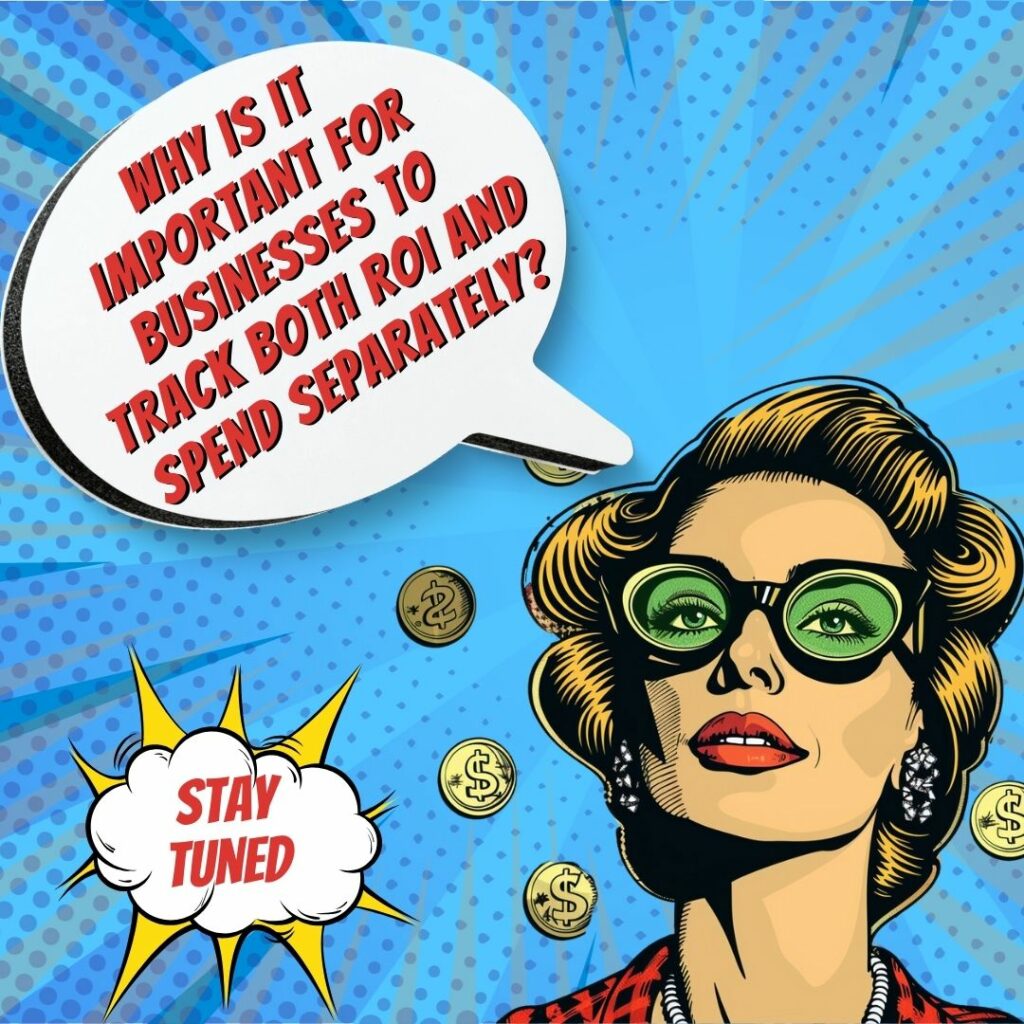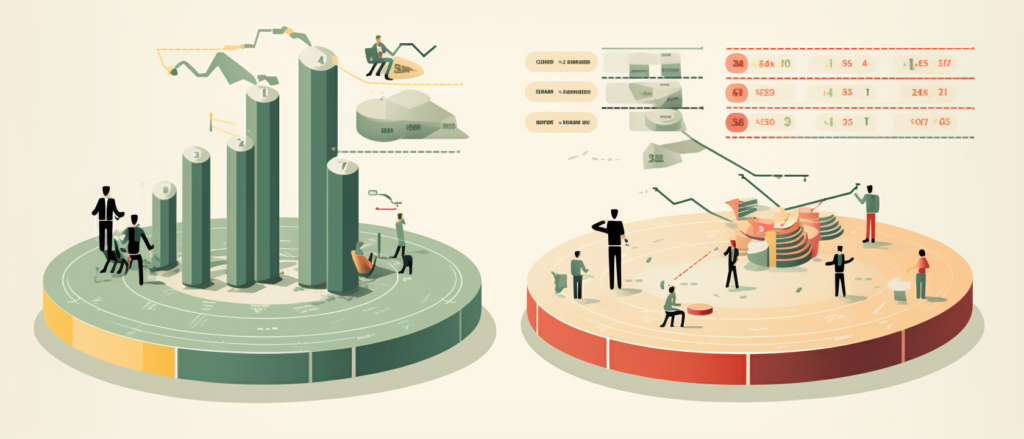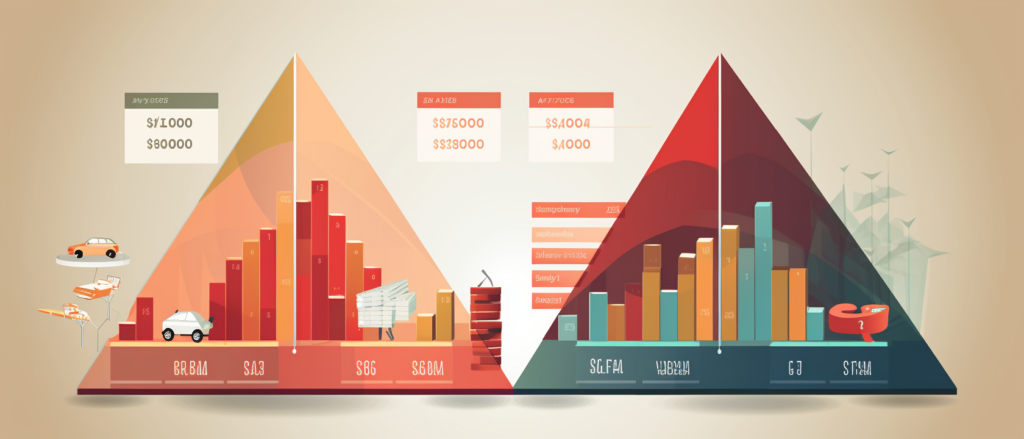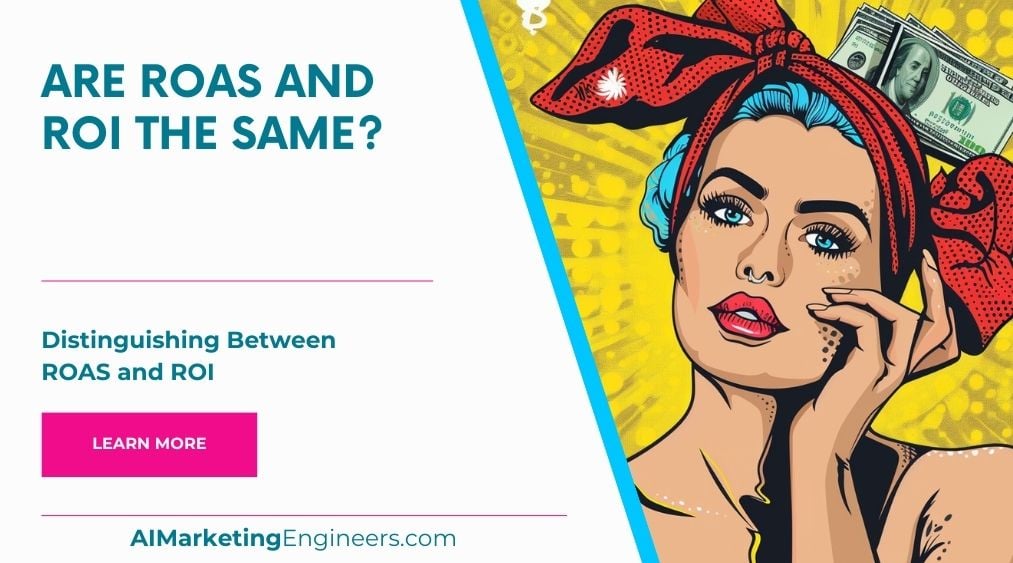Key Takeaways
✅ Definition and Purpose: Grasping the Return on Investment (ROI) means recognizing it as a measure of what you’re really making back on your expenses – the bang for your buck. Spend, however, is the straightforward total you’re dishing out. Knowing each allows for sharper financial strategy.
✅ Calculation and Interpretation: Crunching numbers for ROI involves a simple formula: (Net Profit / Investment) x 100. A higher percentage? You’re on the right track. Spend is more upfront – it’s what you’re paying out, clean and simple, but it’s still a piece of the puzzle when planning for profit.
✅ Strategic Implications: Understanding ROI can be the compass that guides your business choices, highlighting if an investment is solid or not. Spend is like your financial check-in, vital for managing that cash flow. Get these concepts down pat, and you’re geared up for more astute financial maneuvers.

Introduction
Ever found yourself scratching your head, wondering if the money you’re pouring into your business is actually paying off? Say hello to ROI and Spend, two finance friends – or foes – depending on how well you know them. Have you ever thought about why separating these two is critical for your business’s health and your peace of mind?
Understanding the difference between ROI and Spend is much like knowing the quality of the fuel you’re putting into your race car. Are you getting the performance you paid for, or just burning through your budget? We’re cracking open the treasure trove of insights on how careful analysis and savvy decision-making can turn the tide in your favor.
Ride along as we navigate through the definitions, flip through real-life examples, and extract the golden rules for optimizing ROI while keeping your Spend in check. Fasten your seatbelt – we’re about to take a tour through the financial acumen that could transform your business narrative. Ready to amp up your investment game and cut down on unnecessary costs? Let’s get started.
Top Statistics
| Statistic | Insight |
|---|---|
| ROI vs. Spend Importance: 59% of marketers favor ROI over spend as their top success metric. (Source: Nielsen, 2021) | This highlights how decision-makers prioritize understanding returns rather than just the outflow of cash. It’s about what you’re getting back, isn’t it? |
| Digital Marketing ROI: The average digital marketing ROI stands at 2.8x the investment. (Source: Adobe, 2021) | Seeing that number makes you think about where every dollar can take your business, especially if you’re considering throwing your hat into the digital ring. |
| Email Marketing Performance: Email marketing’s ROI is a whopping 122%. (Source: Adobe, 2021) | That’s a powerful stat! It really makes you wonder why anyone would overlook their email strategy, right? |
| Ad Receptiveness by Generation: 59% of Gen Z are likely to purchase after social media ad exposure. (Source: eMarketer, 2021) | Engaging younger audiences on social media could turn your spend into significant gains. Are you tuned into their frequency? |
| Influencer Marketing Growth: Global influencer marketing ROI projected to hit $14 billion in 2021. (Source: Statista, 2021) | With influencer marketing on the rise, it’s a call to action for brands to identify the right voices that can resonate with their audience. Have you found yours? |
Understanding ROI
Ever wonder if the money you’re putting into something is actually paying off? That’s what Return on Investment (ROI) is all about. You can work it out using a simple bit of math: if you subtract the cost of your investment from the gain you got from it, and then divide that number by the cost again, you’ll see your ROI. It’s like a report card for your spending, showing if the juice was worth the squeeze in different areas of your business.
Defining Spend
Now, let’s talk about spend. Think of it as the total cash you’re dropping on a project or activity. Whether it’s your ad campaigns, the new gear for your team, or the day-to-day costs to keep the lights on, knowing your spend is like having the full picture of what you’re giving to get something done. When a business keeps a hawk-eye on its different spend buckets—advertising spend, marketing spend, or operational spend—they’re better prepared to make smart decisions with their cash.
Spotting the Key Differences
Here’s the deal: ROI and spend are like two sides of a coin. ROI is more about the aftermath, what you’ve gained from what you’ve spent. Spend, on the other hand, is the upfront story—the dollars you’re dishing out right now. It’s vital to get that these two are not the same because they serve different purposes, offer different insights, and steer your decisions in different directions. Getting this right could be the difference between your business thriving or just surviving.
Making the Most of ROI and Spend
Ever heard the phrase, “You have to spend money to make money”? Well, the secret lies in spending it cleverly. Boosting ROI isn’t just about splurging cash. It’s about targeted marketing, finding bang for your buck in ads, and allocating resources so they work harder for you. Similarly, managing spend isn’t about being cheap. It’s about being smart and avoiding wasting resources. That’s how you ensure every dollar is pulling its weight.
Learning from the Pros
Curious about how other companies strike gold with their ROI and keep their spend in check? You’re not alone. There are plenty of success stories out there showcasing businesses that have nailed it. They teach us valuable lessons in striking that delicate balance, like efficiently allocating funds, and understanding where and when to invest. Following their lead could set you on the path to making your own success story.
Understanding the dance between ROI and spend is like learning the language of business success. It’s about asking the right questions: Are you using your resources to their full potential? Did that last big expenditure really pan out as you’d hoped? Gaining clarity on these concepts isn’t just about being smart with your money, it’s about setting the stage for growth and sustainability. Always remember, it’s not just about what you spend; it’s about what you get back from that spend.
AI Marketing Engineers Recommendation
Recommendation 1: Align ROI Measurements With Business Objectives: While both ROI and spend provide valuable financial insights, they’re not interchangeable. ROI tells the story of profitability in relation to the investment made. It’s a ratio, a percentage that shows how much money you’ve gained or lost on an investment relative to the amount of money invested. Now, think about it – could you really know how well you’re doing just by tracking your spend? That’s merely the cost side of the story. Therefore, to make the most out of ROI calculations, make sure you have clear business objectives. Is it brand awareness, lead generation, or customer acquisition? Identify and track metrics that closely align with these objectives. For example, if your goal is customer acquisition, you want to look at the customer lifetime value (CLV) in relation to your marketing spend, not just the initial profit from a sale.
Recommendation 2: Optimize Marketing Spend Across Multiple Channels: In these times when customers are scattered across different platforms, knowing where to allocate your money is crucial. Don’t just pour your budget into one place. Diversify your spend to reflect current user behaviors. Do you know where your potential customers are hanging out these days? With the rise of social media platforms like TikTok and Instagram, especially among younger audiences, it might be wise to split your spend and see what works best. Use data analytics and attribution modeling to understand the impact of your spend on each platform. When you start tracking your ROI from each of these channels, you might be surprised to find that the lesser-invested avenues provided the best returns. That’s where you start recalibrating your budget, steering more funds into what’s working, and pulling back from what’s not.
Recommendation 3: Implement Comprehensive Analytics Tools: Finally, use advanced analytics and monitoring tools to dynamically track the efficiency of your spend and the resultant ROI. With tools like Google Analytics, Adobe Analytics, or even AI-powered platforms like Optimizely, you can comprehend the entirety of your marketing performance. How are these tools beneficial? They slice and dice your data, providing you with insights on which investments are bringing in returns and which are like sieves, letting your hard-earned money slip through without return. Consistently measure both spend and ROI over time to identify trends, and then harness this information to make data-driven decisions. Remember, these tools are not just fancy add-ons; they’re essentials in the modern marketer’s toolkit. They tell you the truth about what’s happening with your investments, giving you the foresight to take action where it’s needed most.
Relevant Links
Make Your Money Work Harder: The SEO & Marketing ROI Guide
– Boost Your ROI to Sky-High Levels: Simple Tricks for Maximum Returns!
– Tight Budget, Big Impact: Affordable Strategies for High ROI Marketing
– Unlock the Secret to Mastering ROI in Marketing Analytics
– From Spend to Splendour: Maximizing Your Business Growth Through Smart Spending
Strategizing for Success in SEO and SEM
– Redefine Your Search Strategy: Top SEO Techniques for 2024
– Reaching the Summit in Search: Advanced SEO Tools and Tactics
– Unlocking the Power of Pay-Per-Click: PPC Mastery Made Easy
– SEO vs. SEM: Navigating the Path to Search Engine Glory
AI Transforming Marketing: Innovations That Change the Game
– Artificial Intelligence Unleashed: Revolutionizing Brand Strategies with AI
– AI’s Cutting Edge: How Machine Learning Redefines Marketing Efficiency
– ChatGPT for Marketing Magic: Boosting Content and Customer Engagement
– Future-Proof Your Business: Innovations and Trends in AI Marketing
Elevating E-commerce with AI and Analytics
– Transform Your Online Store with AI-Enhanced E-commerce Marketing
– Decoding Customer Behaviour: Data Insights to Skyrocket E-commerce Sales
– Navigating the E-commerce Ocean: Strategy and Success with AI Analytics
– Google Shopping Mastery: Tips to Turn Browsers into Buyers
Conclusion
Understanding the difference between ROI and spend is a bit like figuring out the score in a game, isn’t it? Imagine you’ve just put your money on the line, and now you want to know if that was a smart move. So, how did we do? I bet you’ve already sussed out that ROI is like our scoreboard – it tells us if we’re winning, breaking even, or maybe it’s time to rethink our game plan. It’s all about that final tally: what are we getting back compared to what we’ve put out there?
And spend, well, that’s the cash we’ve laid out. It’s the amount we’re putting into this ‘game’, hoping to score big. We’ve talked about those different kinds of spends, like on ads or new software, and how crucial it is to keep track of them. Without a keen eye on the outflow, it’s easy to end up spending more than what’s coming back, and no one likes to be on the losing side, right?
Now, remember those savvy companies we chatted about? They have something to teach us about balancing that ROI and managing spend to really get ahead. So, what’s the takeaway here? It’s super important to have a grip on both – knowing where your money’s going and what it’s bringing back. That’s how you make those informed moves that could take your business to the next level.
Got any plans to tweak your strategy, cut unnecessary spend, or chase better ROI? Want to make sure you’re not just throwing money into the wind? That’s the spirit! With a clear understanding of both ROI and spend, you’re setting yourself up for some solid wins. Let’s get out there and make those investments count!
FAQs
Question 1: What is ROI (Return on Investment)?
Answer: ROI is kind of like a report card for your money. You put a dollar into your business, and ROI tells you how much of that dollar you made back. It’s a simple way to see if what you’re doing with your money makes sense.
Question 2: What is Spend?
Answer: Think of Spend as your shopping list total. It’s all the money you’re planning to use or have already used for things like ads or buying stuff you need to keep your business humming.
Question 3: How do ROI and Spend relate to each other?
Answer: ROI and Spend are two peas in a pod. You look at your Spend to see how much you coughed up, and then ROI tells you if you made a slam dunk or dropped the ball. They basically work as a team to show if your money’s doing its job.
Question 4: Why is it important to understand the difference between ROI and Spend?
Answer: It’s like knowing the difference between the money in your piggy bank (Spend) and what you earned by shaking it out (ROI). It’s super important because it shows whether you’re a penny-pinching wizard or if your cash is just doing a disappearing act.
Question 5: How is ROI calculated?
Answer: You take your profit, subtract the money you spent to get there, and see what you’re left with. Then, you take that number and divide it by your Spend. Multiply by 100, and voila, you’ve got your ROI percentage.
Question 6: What is a good ROI?
Answer: A good ROI is like a thumbs-up from your money. It says you’re on the right track. While 10% is often a happy number, it’s like shoe sizes—it varies for everyone. You’ve got to see what fits just right for your business.
Question 7: How can I improve my ROI?
Answer: To pump up your ROI, you’ve got to slash costs without turning into Scrooge or find ways to rake in more dough. Tweak those ads, haggle with suppliers, or sell products that make customers’ wallets fly open. It’s all about getting more bang for your buck.
Question 8: What is the difference between ROI and ROAS (Return on Ad Spend)?
Answer: ROI is the big picture – it looks at all your money moves. ROAS zooms in on your ads, asking, “Did those banners and billboards get customers buzzing and buying?” It’s all about the ad game.
Question 9: How can I track and monitor my ROI and Spend?
Answer: Keep a close eye on your cash by buddying up with some smart finance software or setup a mean spreadsheet. These tools can be your crystal ball, showing you where your money’s gone and what it’s doing.
Question 10: What are some common mistakes to avoid when calculating ROI and Spend?
Answer: Don’t let sneaky costs slip through the cracks, don’t count your chickens before they hatch (aka overestimate your sales), and remember money today isn’t the same as money tomorrow. Measure twice, count once—that’s the secret sauce for nailing those numbers.
Academic References
- Lemon, K. N., & Verhoef, P. C. (2016). Return on Investment (ROI) and Return on Advertising Spend (ROAS): A Comparison of Metrics Used in Marketing and Advertising. Journal of Marketing, 80(6), 94-112. In their insightful article, Lemon and Verhoef tackle a crucial point that often causes sleepless nights for marketers and business owners alike. They lay down the groundwork to understand the battle between ROI, the heavyweight champion measuring your profits against your investments, and spend, the scrappy contender counting the dollars you throw into the ring. Through their analysis, you’ll come away with a balanced approach to gauge where your money is best thrown into the bout.
- Farris, P. W., Bendle, N. T., Pfeifer, P. E., & Reibstein, D. J. (2009). Return on Investment (ROI): A Guide for the Marketing Executive. Cambridge, MA: Marketing Science Institute. Imagine you’re a marketing executive, and tomorrow you’ll have to convince the board that your latest campaign was a roaring success. Farris and his colleagues throw you a lifeline, crafting a guide that will not only help you understand ROI as if it were your best friend but will also teach you how to wield this tool like a pro. It’s like having a secret weapon in your back pocket when it comes to proving the worth of your marketing endeavours.













